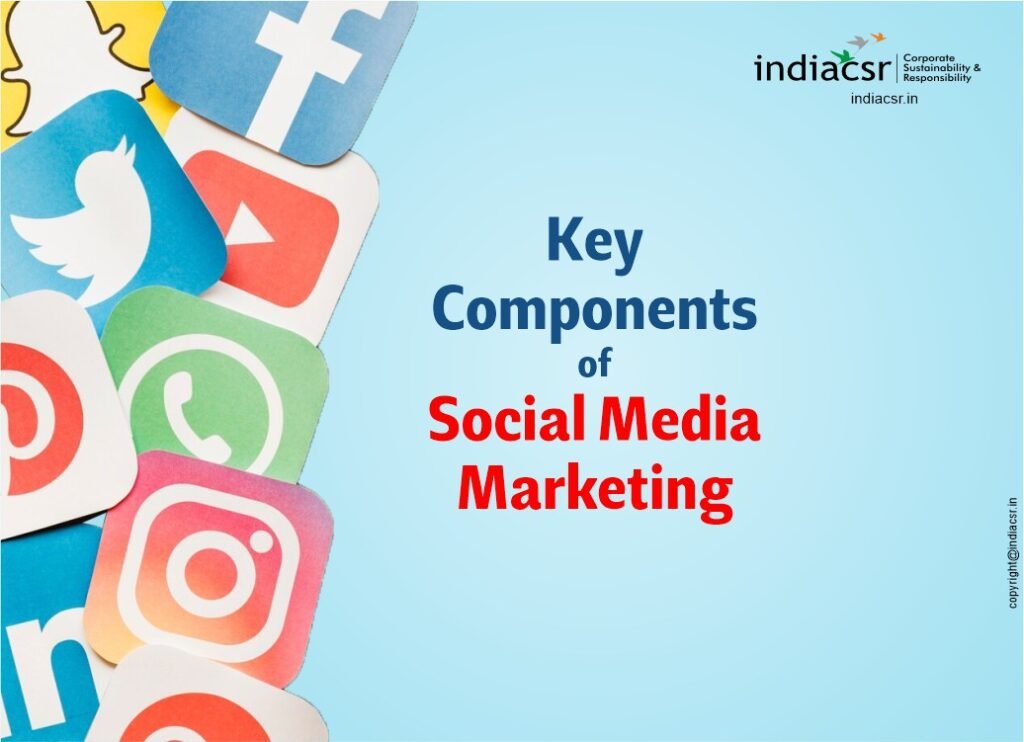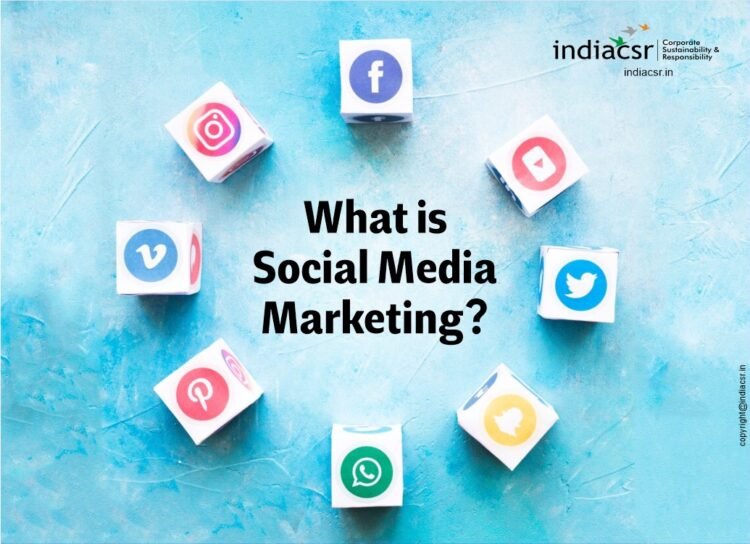Social media marketing is a powerful digital strategy that harnesses social media platforms to promote your brand, connect with your target audience, and achieve specific business goals. It involves deliberate efforts to engage, inform, and influence your audience through various social channels.
Social media marketing has become an integral part of business strategies worldwide. With 4.9 billion people using social media platforms globally, having a presence on these channels is essential for connecting with both current and potential customers. Let’s delve into what social media marketing is, its benefits, key components, and best practices.
Social media marketing (SMM) has revolutionized how businesses engage with their audiences. It involves using social media platforms to promote products, services, or brands, leveraging the vast user base of platforms like Facebook, Twitter, Instagram, LinkedIn, and TikTok. This marketing strategy integrates traditional marketing principles with the interactive and real-time nature of social media to build a brand’s presence, generate leads, and foster customer relationships.
The Evolution of Social Media Marketing
Social media marketing has evolved significantly since its inception. Initially, platforms like MySpace and Friendster were used primarily for personal connections. With the rise of Facebook in 2004, businesses began recognizing the potential of these platforms for marketing purposes. Today, social media is an integral part of any comprehensive marketing strategy, offering tools for precise targeting, real-time interaction, and measurable results.
Social media marketing is a form of digital marketing that leverages social media platforms to promote your brand and offerings to your ideal customers. It goes beyond random posts on business accounts; it requires a well-thought-out strategy. Here’s how it works:
- Platform Presence: Create and optimize business profiles on platforms like Facebook, Instagram, Twitter, LinkedIn, and more.
- Content Strategy: Develop a content calendar specifying what, when, and where you’ll post. Use a mix of text, images, videos, and stories to position your brand positively.
- Engagement: Respond to comments, likes, and shares to monitor your reputation and build a community.
- Paid Ads: Depending on your goals, consider paid social ads to reach the right audience at the right time.
Key Components of Social Media Marketing

1. Content Creation
Creating engaging and relevant content is at the heart of SMM. This includes posts, videos, infographics, and stories tailored to the interests of the target audience. The content should provide value, whether it’s through entertainment, education, or information.
2. Community Management
Building and nurturing a community around a brand is crucial. This involves interacting with followers, responding to comments and messages, and fostering a sense of belonging and loyalty among customers.
3. Advertising
Social media platforms offer robust advertising tools that allow businesses to target specific demographics, interests, and behaviors. Paid advertisements can significantly enhance a brand’s reach and engagement.
4. Analytics and Reporting
Monitoring and analyzing the performance of social media campaigns is essential. Metrics such as likes, shares, comments, click-through rates, and conversion rates help businesses understand what works and refine their strategies accordingly.
*****
Benefits of Social Media Marketing
Social media marketing (SMM) offers numerous advantages for businesses of all sizes. Social media marketing offers a multitude of benefits that can significantly enhance a business’s marketing efforts. By leveraging social media platforms, companies can enhance their marketing efforts in various ways, resulting in increased brand visibility, customer engagement, and ultimately, improved sales and profitability. From increasing brand awareness and customer engagement to providing valuable insights and driving website traffic, SMM is a powerful tool for achieving marketing goals. By leveraging the unique features of social media platforms and staying adaptable to emerging trends, businesses can maximize their success in the digital age.

Below are the key benefits of social media marketing:
1. Increased Brand Awareness
Broad Reach
Social media platforms have billions of active users. For instance, Facebook alone boasts over 2.8 billion monthly active users as of 2023. This vast user base allows businesses to reach a global audience with minimal effort.
Viral Potential
Content shared on social media can go viral, exponentially increasing its reach. Engaging posts, videos, or images can be shared by users, leading to a ripple effect that spreads the content far beyond the original audience.
2. Higher Engagement
Direct Interaction
Social media enables direct communication between brands and consumers. Businesses can respond to comments, answer queries, and engage with their audience in real-time, fostering a sense of community and loyalty.
Customer Feedback
Platforms like Twitter and Facebook allow customers to voice their opinions and provide feedback. This interaction helps businesses understand customer needs and preferences, enabling them to tailor their products and services accordingly.
3. Cost-Effective Marketing
Affordable Advertising
Social media advertising is often more cost-effective than traditional marketing methods. Platforms like Facebook and Instagram offer flexible ad budgets, allowing businesses to start with small investments and scale up as needed.
Organic Reach
Businesses can reach their audience without spending on ads through organic posts. Regular updates, engaging content, and active community management can attract followers and increase visibility at no additional cost.
4. Improved Customer Insights
Data Analytics
Social media platforms provide detailed analytics and insights into user behavior, engagement, and demographics. Businesses can track metrics such as likes, shares, comments, and click-through rates to gauge the effectiveness of their campaigns.
Market Research
By monitoring conversations and trends on social media, businesses can conduct market research and gain valuable insights into industry trends, competitor activities, and customer preferences.
5. Enhanced Brand Loyalty
Building Relationships
Regular interaction with customers on social media helps build strong relationships. Responding to comments, addressing concerns, and acknowledging positive feedback can create a loyal customer base.
Humanizing the Brand
Social media allows businesses to showcase their human side. Sharing behind-the-scenes content, employee stories, and community involvement initiatives can make a brand more relatable and trustworthy.
6. Increased Website Traffic
Referral Traffic
Social media posts and ads can drive traffic to a company’s website. By including links to blog posts, product pages, or landing pages, businesses can attract visitors and convert them into customers.
SEO Benefits
Active social media presence can indirectly boost search engine rankings. Increased engagement and traffic from social media can signal to search engines that a website is valuable and relevant, improving its visibility in search results.
7. Higher Conversion Rates
Targeted Advertising
Social media platforms offer advanced targeting options based on demographics, interests, behaviors, and location. This precision targeting increases the likelihood of reaching potential customers who are more likely to convert.
Retargeting Campaigns
Businesses can use retargeting ads to reach users who have previously interacted with their brand. These ads remind potential customers about products or services they viewed, encouraging them to complete the purchase.
8. Competitive Advantage
Staying Current
By actively participating in social media, businesses can stay up-to-date with industry trends and competitor activities. This awareness helps them adapt their strategies and maintain a competitive edge.
Customer Acquisition
An effective social media strategy can attract new customers who may not have discovered the brand through traditional marketing channels. Engaging content and targeted ads can capture the attention of potential customers and drive growth.
9. Flexibility and Adaptability
Real-Time Marketing
Social media allows businesses to respond to current events, trends, and customer feedback in real-time. This agility enables them to capitalize on opportunities and address issues promptly.
Diverse Content Formats
Businesses can experiment with various content formats on social media, including text posts, images, videos, live streams, and stories. This flexibility allows them to find the most effective ways to engage their audience.
*****
Examples of Successful Social Media Marketing Campaigns
1. Nike’s “Just Do It” Campaign
Nike has consistently leveraged social media to amplify its iconic “Just Do It” campaign. By collaborating with athletes and influencers and encouraging user-generated content, Nike has maintained a strong brand presence across platforms like Instagram and Twitter.
2. Coca-Cola’s “Share a Coke” Campaign
Coca-Cola’s “Share a Coke” campaign personalized bottles with popular names, encouraging customers to share photos of their personalized bottles on social media. This campaign not only increased sales but also generated a massive amount of user-generated content, enhancing brand engagement.
3. Airbnb’s User-Generated Content
Airbnb encourages users to share their travel experiences on social media using specific hashtags. This strategy not only provides authentic content but also builds a community of travelers who share their positive experiences with the brand.
*****
Future Trends in Social Media Marketing
As we look ahead to 2024, several key developments are shaping the landscape of social media marketing. The evolving dynamics present both challenges and opportunities for businesses aiming to stay ahead of the curve. From the resurgence of text-only posts to the rise of platforms like Telegram and the fediverse, these trends highlight the importance of adaptability and innovation in digital marketing strategies. Here are the most important trends to watch:
Several key developments are shaping the landscape. Here are the most important trends to watch:

Text-Only Posts Gain Momentum
While visual content dominates social media, text-only posts are making a comeback. Platforms like X (formerly known as Twitter) remain popular for sharing concise, written content.
New players like Mastodon, Bluesky Social, and Meta’s Threads app are also gaining traction, emphasizing text-based communication.
Action Point: Consider incorporating text-focused posts into your content strategy to engage users who crave meaningful written content.
Social Platforms as Search Engines
Social media platforms are evolving into search engines. Users increasingly turn to platforms like Instagram, Pinterest, and YouTube to discover products and services. Optimize your content for social SEO by using relevant keywords, hashtags, and descriptive captions.
Longer Videos Make a Comeback
Short-form videos have been dominant, but longer videos are re-emerging. Platforms like YouTube and TikTok are embracing extended video formats.
Consider creating in-depth video content to engage your audience and provide value.
Shift from Feeds to Direct Messages (DMs)
Engagement is moving away from public feeds to private conversations. DMs on platforms like Instagram, Facebook, and WhatsApp are where meaningful interactions happen. Prioritize personalized responses and build relationships through direct messaging.
Shares Trump Likes and Comments
Shares (or retweets) are becoming more valuable than likes or comments. A shared post reaches a broader audience and indicates genuine interest.
Encourage users to share your content to amplify its impact.
Rise of Telegram and the Fediverse
Telegram is gaining popularity as a secure messaging app with features beyond traditional social media1.
The fediverse, a decentralized network of interconnected social platforms, is an emerging trend, although it’s not mainstream yet.
Authenticity Reigns Supreme
Authentic content resonates across platforms. Users crave transparency, real stories, and genuine connections.
Showcase your brand’s human side and build trust with your audience.
Social Media Managers and AI Collaboration
Social media managers will increasingly collaborate with AI tools for data analysis, content scheduling, and personalized recommendations.
Embrace AI to enhance efficiency and effectiveness. Artificial intelligence and automation are transforming social media marketing. Tools like chatbots, automated posting, and AI-driven analytics are helping businesses manage their social media presence more efficiently and effectively.
LinkedIn’s Evolution
LinkedIn will continue to evolve. It may deprioritize personal content and attract more Gen Z users. Explore LinkedIn’s features for professional networking and B2B marketing.
TikTok Shop and Authenticity
TikTok Shop will emphasize authenticity. Brands should focus on genuine, relatable content rather than overly polished ads. Be real, and your audience will respond positively.
Rise of Video Content in Social Media Marketing
Video content continues to dominate social media. Platforms like TikTok, Instagram Reels, and YouTube Shorts are becoming increasingly popular, and brands are leveraging these formats to create engaging and shareable content.
Social Commerce
Social commerce is the integration of e-commerce with social media platforms. Features like Instagram Shopping and Facebook Marketplace allow users to purchase products directly from social media, making the buying process seamless and convenient.
Personalization
Personalized marketing is becoming more prevalent. By leveraging data analytics, brands can create highly targeted and personalized content that resonates with individual users, increasing the likelihood of engagement and conversion.
Remember, the social media landscape is dynamic. Stay informed, adapt your strategy, and embrace these trends to thrive in 2024!
Conclusion
Social media marketing is a dynamic and powerful tool for businesses looking to enhance their brand presence, engage with their audience, and drive sales. By understanding the key components and staying abreast of emerging trends, businesses can effectively leverage social media to achieve their marketing goals. As platforms continue to evolve and user behavior shifts, staying adaptable and innovative will be crucial for success in the ever-changing landscape of social media marketing.
(India CSR)







